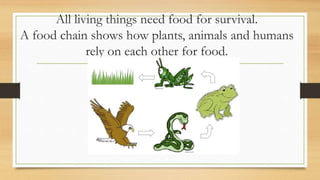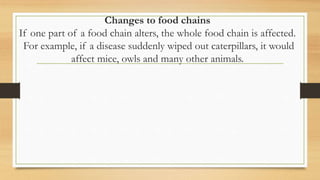FOOD CHAINS UNIT 3 YEAR 3
- 1. FOOD CHAINS
- 2. All living things need food for survival. A food chain shows how plants, animals and humans rely on each other for food.
- 3. Animals get energy and nutrients by eating other animals or plants. Carterpillars eat leaves Mice eat carterpillars Owls eat mice
- 4. The arrow means is eaten by
- 5. Nearly all food chains start with a plant. The lettuce is eaten by the slug, the slug is eaten by the bird.
- 6. Food Chains A food chain shows what is eaten. The lettuce is eaten by the rabbit.
- 7. Food Chains A food chain shows what is eaten. The fly is eaten by the thrush.
- 8. The top of the food chain. Some animals are said to be at the top of the food chain. This is because they are not hunted by other animals. No other animal hunts the lion. The lion is at the top of the food chain. Can you think why?
- 9. Producers âĒ Plants do not eat other plants or animals. âĒ Plants are called producers, because they produce their own food using sunlight.
- 10. Consumers âĒ âConsumeâ means âeatâ. âĒ Animals are consumers because they âeatâ (consume) food provided by plants or other animals.
- 11. Decomposer They eat decaying matter - dead plants and animals and in the process they break them down and decompose them. They release nutrients and mineral salts back into the soil - which then will be used by plants Bacteria and fungi are decomposers.
- 12. Changes to food chains If one part of a food chain alters, the whole food chain is affected. For example, if a disease suddenly wiped out caterpillars, it would affect mice, owls and many other animals.
- 13. Which do you think comes first in the food chain?
- 14. Producer Secondary consumerPrimary consumer The Food Chain Eaten By Eaten By Who is the Producer?
- 15. Is the fox a producer or a consumer?
- 16. Producers Consumers Can you sort these into the right categories?
- 17. Can you give me one example of a carnivore? Can you give me one example of a producer? Can you give me one example of a consumer? Can you tell me what a herbivore is? Can you tell me what an omnivore is? Can you tell me what a carnivore is? So what can you tell me about this ladybird now?
















